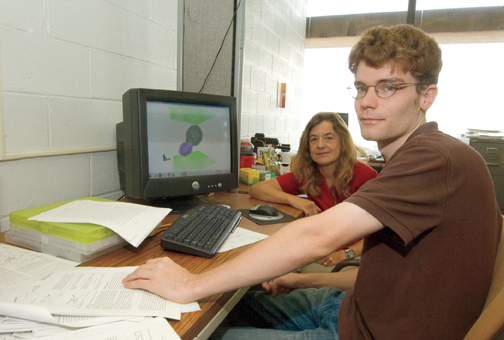Undergraduate Research/Will Uspal

A professed computer geek combines his interest in programming with a new passion—biophysics—thanks to Pitt’s Honors College
This is the second in a series of Pitt Chronicle articles profiling outstanding University of Pittsburgh undergraduate researchers.
Pitt senior William “Will” Uspal launched his computer-programming career the day an uncle gave him a cast-off computer and a book about programming. Soon, Uspal was writing code for computer games that he created. When he needed answers to programming questions, he posted those questions on dial-up electronic bulletin boards.
“I just wanted the computer to do what I wanted it to do,” Uspal sheepishly explains. “But I don’t think other people really appreciated my being on those bulletin boards, because I posted a lot of stupid questions.”
Then again, Uspal was only a fourth grader at the time.
By the time he was in high school, Uspal and his friends were building customized computers and linking them to play “shoot ‘em-up” games like Quake and Doom.
This past summer, the University Honors College gave Uspal, a professed computer geek, an opportunity to combine his long-standing interest in programming with a new intellectual passion: biophysics.
Uspal was one of 60 Pitt students awarded University Honors College Brackenridge Fellowships to pursue summer research projects here. The fellowship program, named for Pitt’s founder, Hugh Henry Brackenridge, awards fellows stipends of $3,000 each to free them from having to obtain summer jobs. Brackenridge Fellowships are open to Pitt students from any field and class, from freshmen to seniors.
Uspal—who is majoring in engineering physics and philosophy, and considering adding a mathematics—worked with Pitt School of Engineering Professor Anna Balazs and her research team in the school’s Soft Condensed Matter Theory and Simulation Laboratory. There, Uspal wrote computer programs that provide three-dimensional simulations for exploring the behavior of nanosize fat molecules called amphiphiles. These molecules each have a head that is attracted to water and a tail that is repelled by it.
By grouping amphiphiles together into differently configured clumps, or membranes, and exposing them in a controlled manner to water, heat, light, and other elements and conditions, Balazs’ research team is learning to train them to do different tasks, using water attraction and repellence as catalysts. The goal is to design amphiphile membranes that become, in effect, tiny, automated machines capable of carrying out such tasks as delivering and releasing drugs in the human body or gobbling up pollutants in water.
Uspal’s summer research project was titled “Control of Domain Formation and Budding in Multicomponent Bilayer Membranes.” As that title suggests, it involved terms and concepts unfamiliar to nonscientists. When asked for details about his research, Uspal obligingly draws pictures of membranes—round, flat, and pinched—in the hope of illustrating it in layperson’s terms. The more complex the research, the more feverishly he draws and the more excitedly he talks. Whether or not Uspal succeeds in elucidating his work, his enthusiasm (if not his drawing skill) is impressive.
As much as Uspal enjoys manipulating amphiphiles and writing computer code, he also relished participating last summer in brainstorming sessions with the other students and postdoctoral staff members on Balazs’ research team. “I think a lot of learning and cross-fertilization of ideas happens in casual talk,” he observes.
This past summer’s research project was the fourth for Uspal, currently a fifth-year senior, since enrolling at Pitt in 2002. He spent the summer after his freshman year in a Pitt physics lab, studying the semiconductor silicon carbide. He spent the summers following his sophomore and junior years at Penn State and Cornell universities, synthesizing conductive polymer nanofibers and studying water absorption in glass, respectively.
Uspal plans to pursue an academic career in computational biophysics. He credits a Pitt course that he took as a freshman—University Honors College Engineering Analysis—with setting him on his career path. That course challenged him like no other had done before, he says.
The instructor: none other than the animated Anna Balazs, a Distinguished Professor and Robert Van der Luft Professor of Chemical and Petroleum Engineering, who has served as his research mentor ever since.
“Dr. Balazs threw some pretty sophisticated problems at freshmen who didn’t know what they were doing,” Uspal says with a grin. “I thought it was challenging because it was very open-ended. She’d give us problems, and we’d struggle with them. I was surprised, and interested in continuing it further.”
Balazs says the problems she threw at her Honors Engineering Analysis students “weren’t really homework problems because there were no answers. The students had to find their own answers and support them with data that they collected.” Balazs, whose own research has made her a pioneer in computational nanoscience and engineering, says she thrives on working with highly motivated undergraduates like Uspal in her Honors College-level courses.
“They’re very excitable and show their excitement right away,” she says. They actually tell me, ‘This is so neat. This is so cool.’ And they’re not very subtle about it.”
Balazs works with a small group of new undergraduates each year, assigning them to employ simulation and theory to address what she calls “hard-core engineering problems.” Some of the solutions they develop are so well-thought-out, Balazs says, that over the years she has coauthored academic papers with more than 20 of her more innovative undergraduate students.
“They have boundless energy,” she brags about these students. “They’re not intimidated yet. They’re not biased yet toward ‘It can’t be done.’”
Other Stories From This Issue
On the Freedom Road

Follow a group of Pitt students on the Returning to the Roots of Civil Rights bus tour, a nine-day, 2,300-mile journey crisscrossing five states.
Day 1: The Awakening
Day 2: Deep Impressions
Day 3: Music, Montgomery, and More
Day 4: Looking Back, Looking Forward
Day 5: Learning to Remember
Day 6: The Mountaintop
Day 7: Slavery and Beyond
Day 8: Lessons to Bring Home
Day 9: Final Lessons

